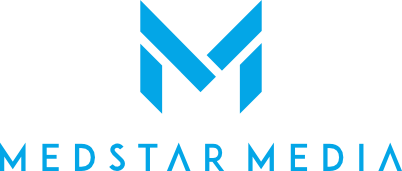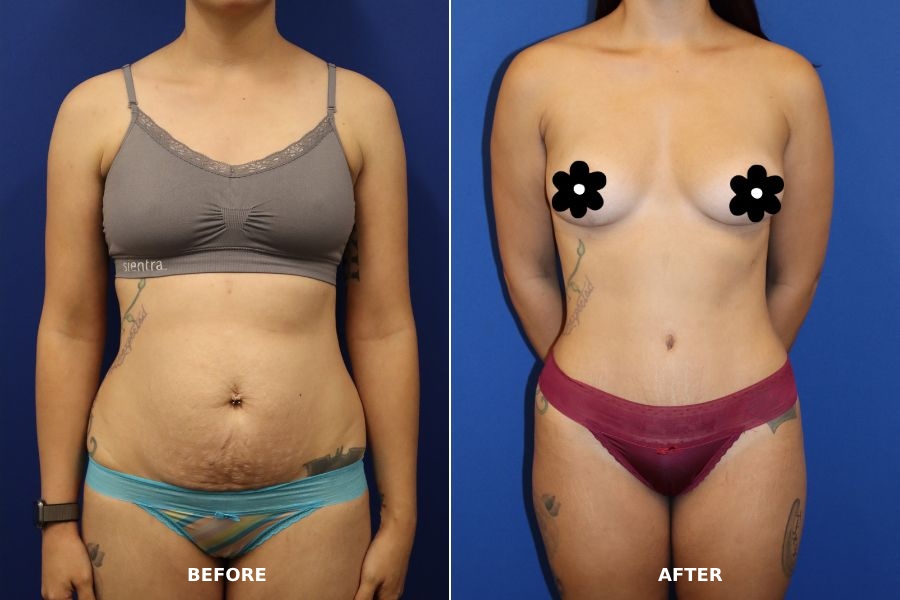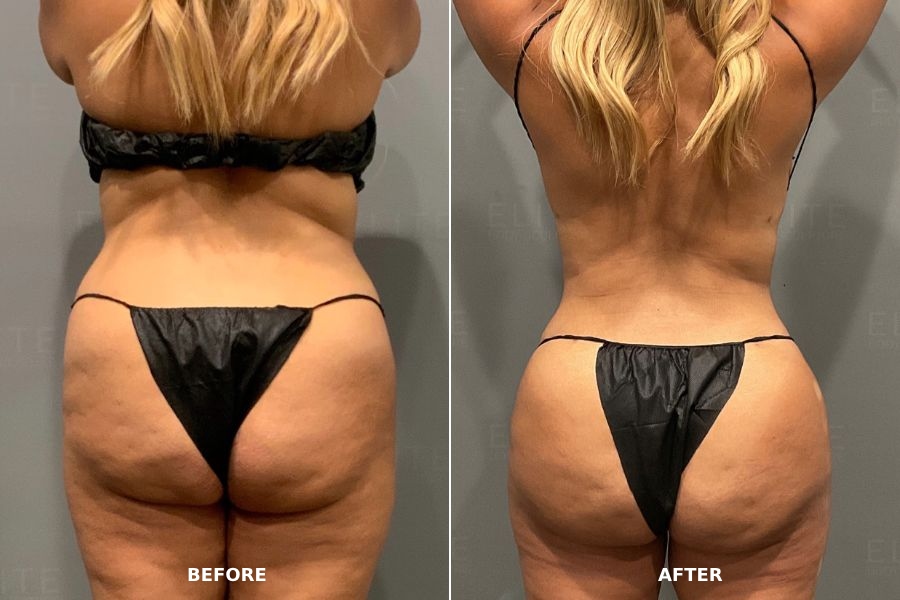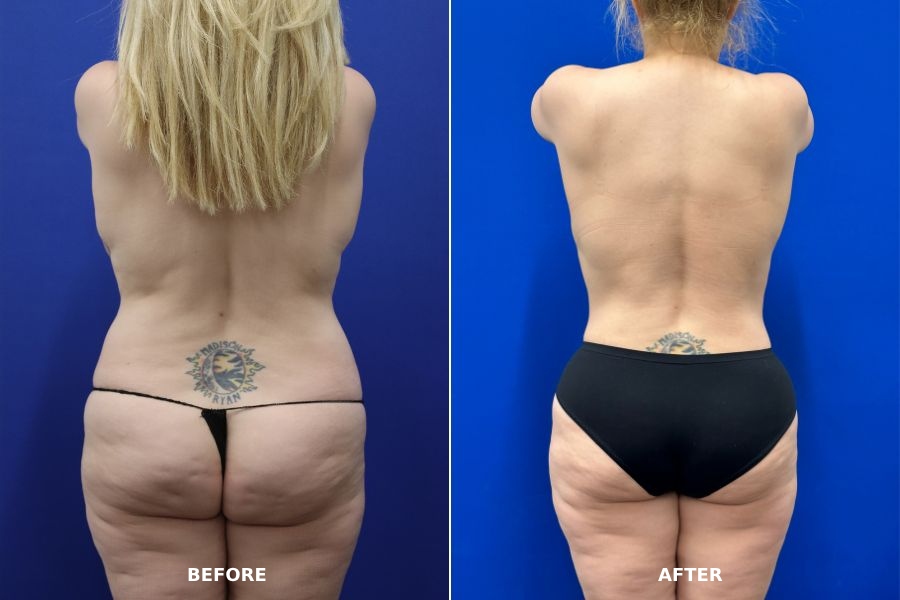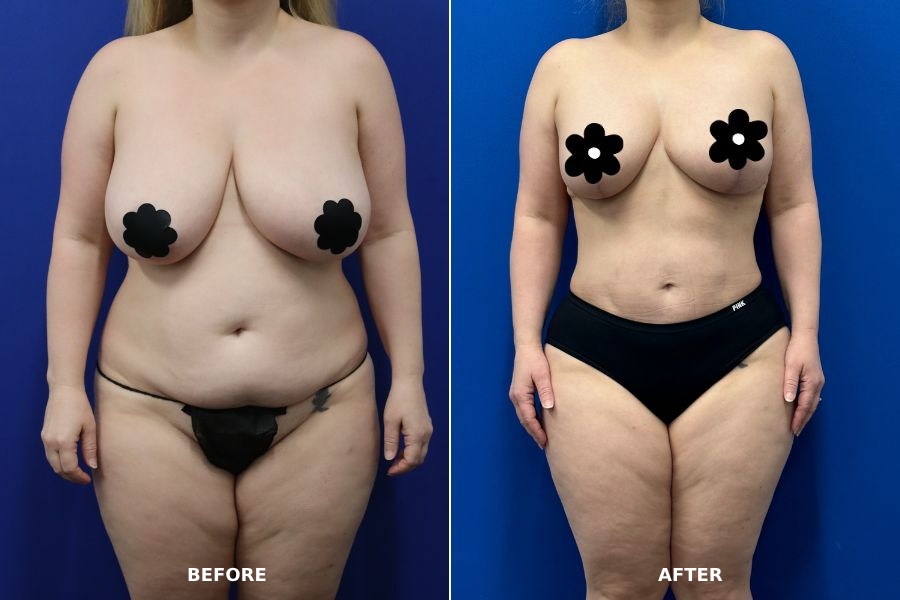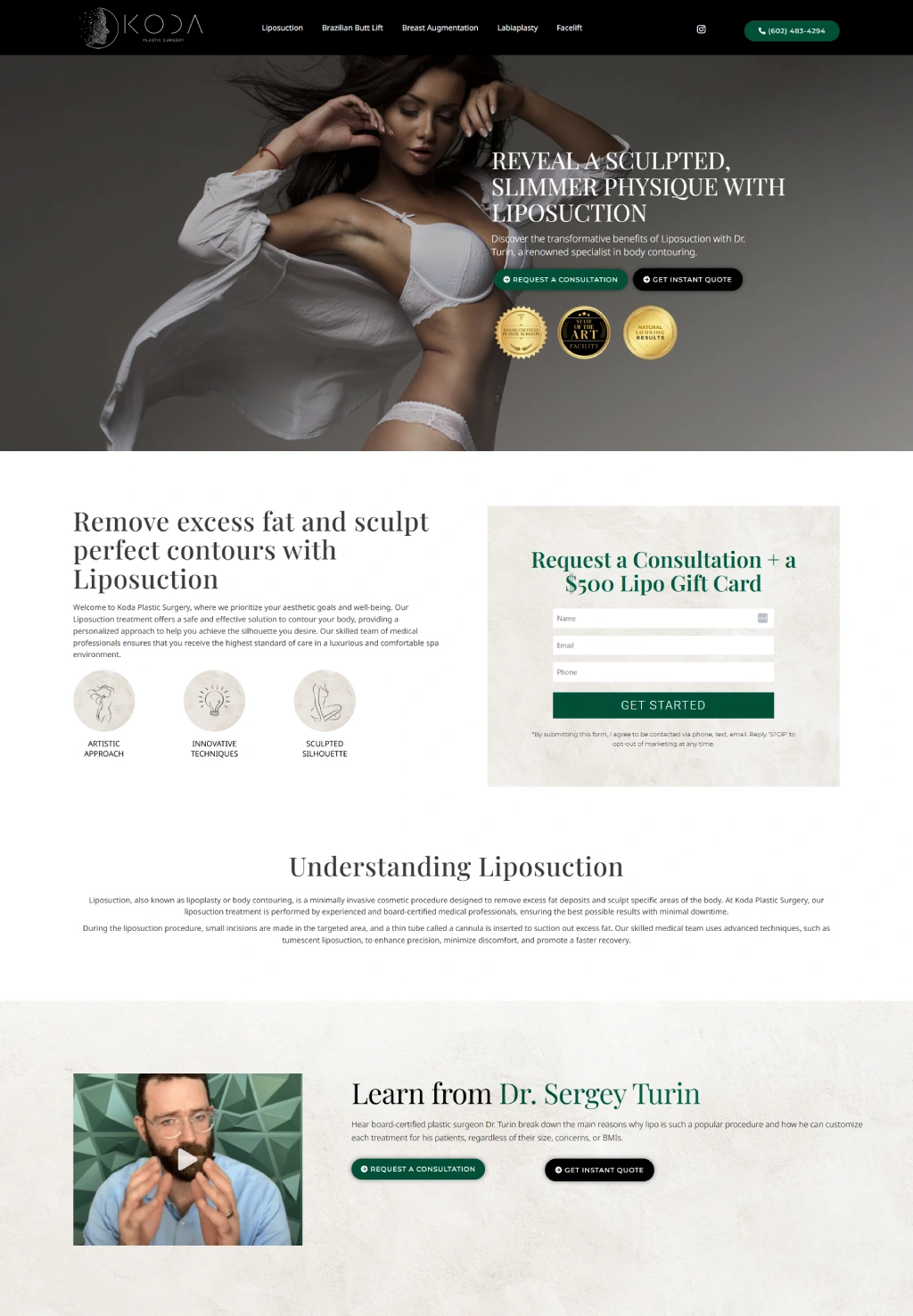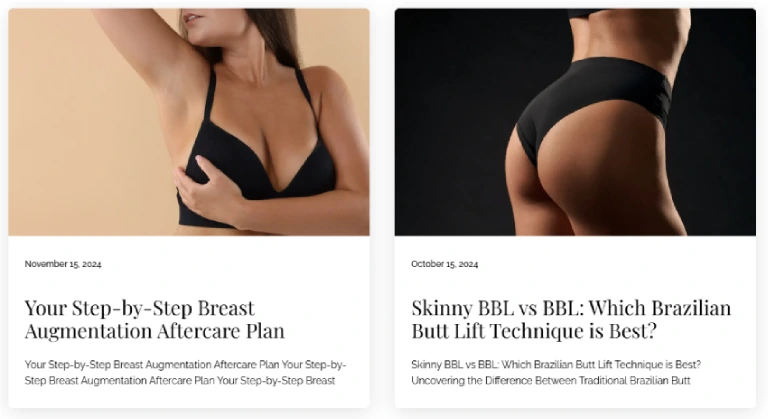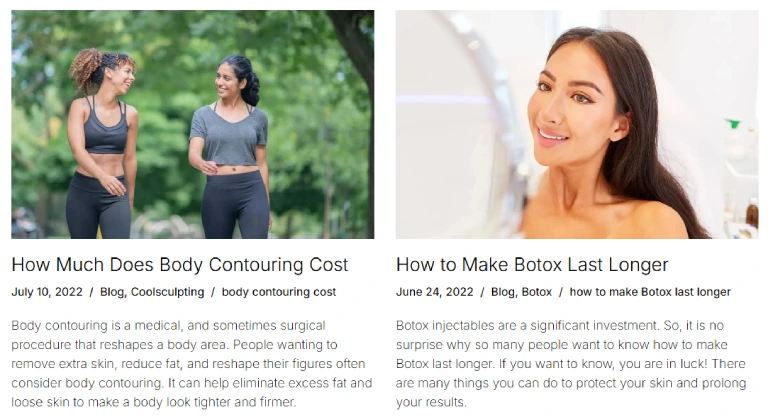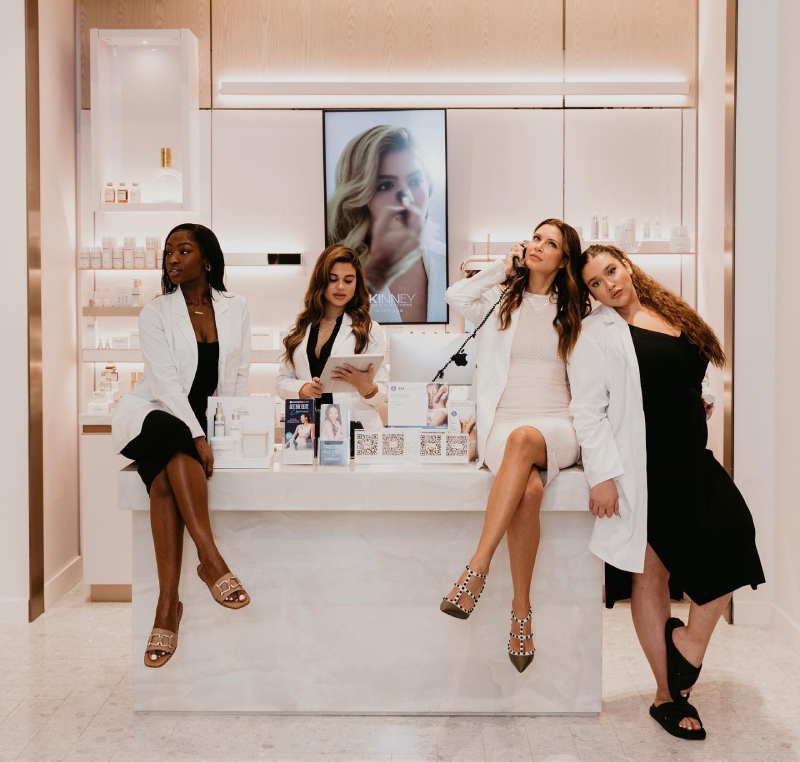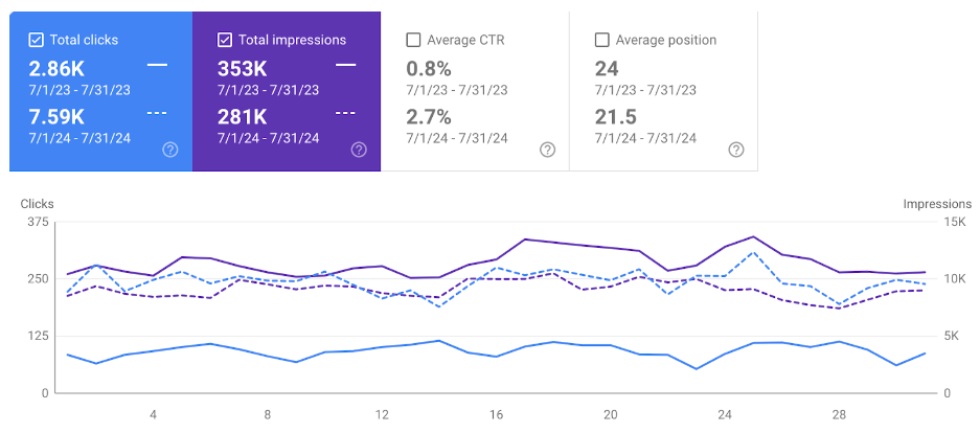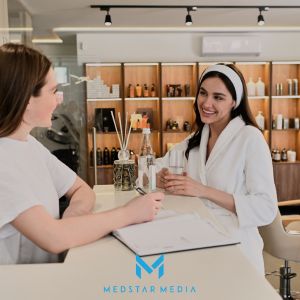If you’ve ever felt like Facebook and Instagram were out to get you, you’re not crazy and definitely not alone. For aesthetic providers, getting ads approved (and keeping accounts live) on Meta’s ad platform has become a frustrating game of chance.
Continue reading9 Genius Ways to Market Your Weight Loss Clinic
Standing out in the weight loss industry has become more challenging than ever before. The rise of various GLP-1 medications quickly created a $19 billion prescription market. Meanwhile, the competition from weight loss clinics is growing at a 4.29% rate.
Continue readingEXOMIND: A Game-Changer for Mental Wellness
EXOMIND: A New Era of Mental Wellness is Dawning
BTL, a leader in medical and aesthetic technologies, is excited to announce the launch of EXOMIND, powered by ExoTMS technology—a groundbreaking, non-invasive brain stimulation treatment designed to enhance mental and emotional well-being. The innovative ExoTMS™ technology activates essential brain regions, enhances neuroplasticity, and reinforces neural pathways.
EXOMIND is FDA-cleared for the treatment of depression in the United States, with additional approvals from Health Canada and CE marking for addressing depression, anxiety symptoms, obsessive-compulsive disorder, and excessive eating disorders.
In a recent press release, the company director, Filip Donner, says, “EXOMIND technology demonstrates our commitment to wellness by delivering natural, innovative solutions that empower individuals to reach their full potential.” He continues, “This patient-friendly therapy aligns with our vision of promoting holistic health. Unlike conventional treatments, it provides a natural approach to mental wellness, fostering brain resilience without the side effects often associated with pharmaceuticals.”
“Our record-breaking Q4, with over $220 million in global sales, is a testament to the growing demand for BTL's cutting-edge solutions,” Donner added. “This achievement affirms customers' trust and confidence in our technologies.”
Schedule a Strategy Session
*By submitting this form, you consent to receive automated marketing calls, texts, and emails from Medstar Media. Consent is not a condition of purchase. Reply ‘STOP’ to opt out.
What is EXOMIND?
EXOMIND provides an innovative treatment option for patients seeking a seamless, drug-free alternative. Clinical studies show that patients value EXOMIND’s comfortable, walk-in, walk-out sessions, which take less than 30 minutes. Its user-friendly design enables easy integration into various medical practices, including family and internal medicine.
Several of our providers have already purchased the newest BTL device and say that this treatment is a game-changer in the mental health industry. Not only is it easy to use, but it allows people the opportunity to really take charge of their own mental wellness without the need for prescription medications.
With more than an estimated 8.32 million people in the United States on antidepressants, we can’t help but see EXOMIND as a revolutionary alternative that is going to benefit thousands, if not millions, of individuals—allowing them to improve their quality of life on a multitude of levels.
Why is EXOMIND Marketing Important?
As EXOMIND approaches its release date, it’s important to have a marketing plan before that launch. Why? You want to begin advertising EXOMIND to your client base and accumulate a waitlist for this new mental wellness service.
A well-crafted marketing plan helps:
- Identify the target audience
- Understand their needs
- Tailor messaging that resonates with them
- Create eye-catching creative concepts
It ensures that the right channels are used to reach potential clients, whether through social media, email campaigns, SEO, or local advertising. Additionally, a marketing plan sets clear goals and timelines, enabling a structured approach to building awareness, generating leads, and driving bookings.
By anticipating challenges and allocating resources effectively, the plan minimizes the risk of wasted efforts and ensures a cohesive brand presence. Ultimately, a strategic marketing plan boosts the treatment's visibility and establishes credibility and trust, laying the foundation for sustained growth and long-term client loyalty.
Let's explore these marketing plan tips a bit further:
Zero In on the RIGHT Target Audiences & Buyer Personas
So, what exactly do we mean by “find the right target audience”? Well, your target audiences and buyer personas are crucial when marketing EXOMIND, as they provide a deep understanding of the people who will benefit most from the treatment.
By identifying key demographics, such as stressed professionals, postpartum mothers, high-functioning executives, and patients with poor experiences on SSRIs, marketers can craft personalized messaging that resonates with each group’s unique needs, goals, and pain points.
This tailored approach ensures that every piece of content, from ad copy to email campaigns, speaks directly to the target audiences, fostering trust, driving engagement, and ultimately leading to higher conversion rates.
So, what exactly do we mean by “find the right target audience”? Well, your target audiences and buyer personas are crucial when marketing EXOMIND, as they provide a deep understanding of the people who will benefit most from the treatment.
By identifying key demographics, such as stressed professionals, postpartum mothers, high-functioning executives, and patients with poor experiences on SSRIs, marketers can craft personalized messaging that resonates with each group’s unique needs, goals, and pain points.
This tailored approach ensures that every piece of content, from ad copy to email campaigns, speaks directly to the target audiences, fostering trust, driving engagement, and ultimately leading to higher conversion rates.
1. Stressed Professionals Seeking Cognitive Performance and Focus
- Demographics: Ages 25–45, urban dwellers, tech-savvy, career-oriented.
- Pain Points: Chronic stress, burnout, difficulty concentrating, and maintaining work-life balance.
- Goals: Enhance productivity, mental clarity, and overall cognitive performance without relying on medication.
- Messaging Strategy: Highlight EXOMIND as a tool for mental optimization, offering quick and non-invasive sessions that fit seamlessly into a busy schedule. Emphasize the ability to “reboot” the mind and improve focus naturally.
2. High-Functioning Executives Looking to Boost Mental Clarity
- Demographics: Ages 35–60, C-suite executives, entrepreneurs, high-income earners.
- Pain Points: Decision fatigue, high stress levels, sleep disturbances, and the desire to maintain a competitive edge.
- Goals: Enhance decision-making capabilities, reduce stress, and improve sleep quality.
- Messaging Strategy: Market EXOMIND as a cutting-edge solution for peak mental performance, emphasizing its role in sustaining high-level cognitive functions without the side effects of medication.
3. Patients with Past Poor Experiences with Medications like SSRIs
- Demographics: Ages 30–65, individuals with a history of depression or anxiety, seeking alternative treatments.
- Pain Points: Unwanted side effects from medications, lack of efficacy, and desire for natural treatment options.
- Goals: Find an effective, non-pharmaceutical solution to manage mental health conditions.
- Messaging Strategy: Present EXOMIND as an FDA-cleared treatment for chronic depression, offering a new path to mental wellness without the drawbacks of traditional medications.
How to Best Understand Your Client’s Needs
To create effective marketing that truly connects, you must first understand the specific needs, pain points, and motivations of your ideal EXOMIND client. Mental wellness is deeply personal, so your outreach must be empathetic, precise, and well-informed. Here’s how to do it:
1. Review Your Current Client Demographics
Analyze your existing client base. Who already comes to your practice for related services like stress reduction, burnout support, or holistic wellness? Look at patterns in age, occupation, lifestyle, and location. This can help you predict who’s most likely to be interested in EXOMIND.
2. Conduct Informal Surveys or Consultations
Use short surveys via email or in-practice forms to gauge client interest in mental wellness services. Ask questions like:
- “Would you be open to non-invasive mental wellness treatments?”
- “What are your biggest mental or emotional wellness challenges right now?”
- “What outcomes would you hope to achieve from a service like EXOMIND?”
The feedback gathered can reveal core motivators. Whether it’s better focus, less anxiety, improved sleep, or emotional balance.
3. Listen on Social Media & Online Communities
Tap into Facebook groups, Reddit forums, or Instagram comments where your target audience discusses stress, burnout, or alternative wellness approaches. Their language and concerns can help you shape messaging that speaks directly to their mindset.
4. Train Your Front Desk & Providers to Ask Questions
Equip your team with a few simple conversation starters like:
- “Have you ever considered something drug-free for mental clarity or stress?”
“What’s been your biggest mental roadblock lately?”
Their answers can help you fine-tune both your offer and your outreach.
5. Build Client Personas Based on This Research
Group your findings into 2–3 client personas. For example:
- The Burned-Out Professional who’s exhausted by work stress
- The Overwhelmed Parent looking for emotional balance
- The Holistic Seeker who prefers natural, drug-free alternatives
These personas can guide the tone, imagery, and offers you use in your EXOMIND campaigns.
Create Solid Campaign Messaging that Resonates With Your Audience
Campaign messaging examples, including ad headlines and call-to-action ideas, are critical for EXOMIND marketing because they serve as the bridge between awareness and conversion. Headlines like “Clear Your Mind. Reclaim Your Life. Without Medication” and “EXOMIND: The Future of Mental Wellness is Here” instantly communicate the unique value proposition of EXOMIND, capturing attention and resonating with prospects who seek drug-free mental wellness solutions.
Some examples include:
Ad Headlines:
“Clear Your Mind. Reclaim Your Life. Without Medication.”
“EXOMIND: The Future of Mental Wellness is Here.”
Call-to-Action Ideas:
“Book your EXOMIND mental reset today.”
“Get drug-free clarity, ask us about ExoTMS.”
Compelling CTAs, such as “Book your EXOMIND mental reset today,” provide clear, action-oriented guidance that encourages immediate engagement. This structured approach to messaging ensures that every touchpoint in the marketing funnel, whether digital ads, social media, or email, speaks consistently and persuasively to the target audience’s needs, driving leads and building trust.
Create Eye-Catching Creative Concepts
Top-performing creative concepts that immediately catch the eye are essential because they shape how potential clients perceive and engage with the treatment. Visuals that showcase clean, clinical environments convey professionalism and safety, helping to build trust. Imagery depicting “mental fog lifting” taps into the emotional appeal of finding clarity, resonating deeply with those seeking relief from cognitive struggles.
Testimonials from real patients and providers add authenticity and credibility, encouraging prospects to take the next step. Infographics that simplify complex scientific information make EXOMIND’s benefits more accessible and easier to understand. Importantly, avoiding terms like “cure” or showing extreme emotional distress ensures compliance with advertising standards while maintaining a positive, hopeful tone that invites prospects to explore EXOMIND as a safe and effective solution.
Do:
- Visuals: Clean, clinical environments showcasing modern technology to convey professionalism and safety.
- Metaphors: Imagery depicting “mental fog lifting” to illustrate clarity and relief.
- Testimonials: Quotes from patients and providers to build trust and credibility.
- Infographics: Simplified diagrams showing how ExoTMS stimulates specific brain regions to educate and inform.
Avoid:
- Using terms like “cure” or depicting extreme emotional distress can be misleading and non-compliant with advertising standards.
Schedule Your EXOMIND Marketing Strategy Session Today
Scheduling a no-obligation marketing strategy session with an expert marketing agency is an excellent opportunity to gain professional insights tailored to your business goals. These sessions allow you to explore innovative strategies, analyze current trends, and identify areas for growth without any commitment.
Medstar Media is a marketing agency you can trust to effectively represent your business and brand. Our strategy is simple. We help you uncover new opportunities, optimize your current efforts, and address challenges specific to your industry. Whether you’re launching a new service like EXOMIND, increasing brand awareness, or looking to attract more clients, a strategy session provides actionable recommendations to set you on the right path. Plus, the no-obligation format ensures you can make informed decisions about your next steps with confidence and zero pressure.
For a free, no-obligation web design and development analysis and consultation, please complete the online form below, call or text (801) 890-3847, or email us at support@medstarmedia.com.

Top Marketing Agencies for MedSpas & Aesthetic Practices

From Ring to Revenue: Mastering Phone Lead Conversions in Aesthetics

Mastering Black Friday & Holiday Promotions: A Complete Guide from an Expert Marketing Agency

Plastic Surgery SEO Strategies to Try This Year, As Told By an Expert Marketing Agency

Membership Mania: How to Turn Your Medspa Team Into Membership-Selling Superstars

The Power of SMS for Medical Practices
*By submitting this form, you consent to receive automated marketing calls, texts, and emails from Medstar Media. Consent is not a condition of purchase. Reply ‘STOP’ to opt out..
6 Creative Approaches to Plastic Surgery Marketing
Plastic Surgery Marketing Strategies
Marketing Tips and Ideas Guaranteed to Grow Your Practice
So, How Should You Approach Plastic Surgery Marketing Today?
#1 Building Your Plastic Surgery Brand
Create an Authentic Plastic Surgery Brand Message
Design Strong, Eye-Catching Visuals for Your Plastic Surgery Brand
#2 Create an Attractive and Informative Plastic Surgery Website
Why Is Your Plastic Surgery Website So Important?
Your website serves as your ultimate marketing tool. It’s the first point of contact for potential patients, offering them the information they need to feel confident about choosing your practice.
A well-designed website allows you to showcase a variety of media—videos, images, and written content—that help educate and inform visitors. Focusing on clear, easy-to-understand content makes the plastic surgery process less intimidating and more approachable. This builds trust and encourages prospects to take the next step: contacting you for a consultation.
Your website isn’t just a digital presence—it’s the foundation of your marketing strategy and a key driver for connecting with your audience.
Plastic Surgery Website Design
When designing your plastic surgery website, it’s important to consider the role of SEO (Search Engine Optimization) and how SEO content integrates into its structure. A sleek and professional website won’t do much for your practice if potential clients can’t find it. Most prospects searching for a plastic surgeon in your area won’t know you by name, so your website needs to be optimized with strategic keywords and high-quality content to rank well on search engines.
Make Your Plastic Surgery Website Content More Engaging
Your website should be more than just a digital business card—it’s a powerful tool for connecting with potential patients and supporting your plastic surgery marketing efforts. Ask yourself: How can my website serve my audience and showcase my practice?
Start by focusing on what matters most to your visitors. Provide clear, relevant content that answers their questions and piques their interest. Be upfront about the procedures you offer and your clinic’s location—this is critical because most prospects are looking for local providers. Highlighting this information informs and builds curiosity about your services, planting the seeds for future consultations.
Showcasing your specialties on your website will ensure that it reflects your expertise. Share your training, certifications, and experience to establish trust and credibility. Use separate pages to organize information about each procedure you offer. This will make your site easy to navigate and allow visitors to find what they need quickly.
- Surgeon Bios: Introduce yourself and your team to build a connection.
- Procedure and Offer Pages: Highlight services and promotions.
- Awards and Accolades: Showcase your achievements.
- Financing Options: Make procedures feel accessible.
- Extra Services: Mention enhancements like consultations or follow-up care.
- A Regularly Updated Blog: Share insights, tips, and news to engage your audience.
#3 Build Strong Plastic Surgery Landing Pages

- Subscribe to a Blog or Email List: Stay connected with prospects by providing valuable updates.
- Download Educational Resources: Offer guide or procedure FAQs to help visitors learn more.
- Request More Information: Encourage visitors to reach out with specific questions.
- Schedule a Consultation: Make it easy for potential patients to take the next step.
- Join a Loyalty or Rewards Program: Build ongoing relationships with your clients.
- Sign Up for a Special Event: Promote open houses or informational sessions to engage with your audience in person.
Creating Engaging and Effective Landing Page Content
Consider your visitors ‘ time and attention when crafting content for your landing pages. Asking for too much information upfront can turn them away. Instead, keep it simple—request only the essentials, like their name and email address, so you can follow up later. The less effort required, the more likely visitors are to respond.
To encourage action, make your landing page appealing and valuable. Share compelling content like:
- Patient Stories: Real-life experiences that build trust and inspire confidence.
- Helpful Resources: Tip sheets, infographics, or FAQs about popular procedures.
- Engaging Media: Links to videos that educate and connect with your audience.
You can also use special offers to draw people in. For example, a Facebook ad promoting a free underarm hair removal session could bring them through your doors. Once they’re in, you can introduce other services like injectables or elective procedures they might already consider. These promotions are a great way to engage new clients and build long-term relationships.
The key is to create landing pages that are inviting, focused, and valuable to your audience. This will make it easy for them to take the next step with your practice.
#4 Provide a Fully SEO-Optimized Plastic Surgery Blog to Engage and Educate Your Audience
A blog can be one of the most effective tools for marketing your plastic surgery practice. Many potential patients start their journey by researching procedures online, and blogs are often their go-to resource for reliable information. Creating a blog with relevant, engaging content educates your audience, draws attention to your clinic, and builds trust with prospective clients.
Use your blog to share insights about your procedures, address common questions, and highlight your expertise. The more valuable and relatable your content, the more likely readers will connect with your practice and take the next step.
Why Your Blog Is a Powerful Marketing Tool
Your blog should be considered one of the most valuable assets in your inbound marketing strategy. It’s a platform where you can position yourself as an expert, connect with potential patients, and educate them about the wide range of procedures you offer.
Beyond building trust and authority, a well-maintained blog boosts your search engine rankings by consistently producing indexable content. This increases your visibility online, making it easier for prospects to find you.
Additionally, an informative blog benefits your visitors by improving their understanding of various procedures. This often leads to more productive consultations, as patients come in with a clearer idea of what they want and what to expect. Your blog isn’t just content—it’s a bridge that connects your expertise with the needs of your audience.
What Makes a Great Plastic Surgery Blog
A great blog doesn’t just share information—it connects with readers meaningfully. To achieve this, approach your blog content with purpose and focus on topics that genuinely matter to your patients. Start by educating your audience about popular surgical and nonsurgical procedures, as they’re often curious about.
Don’t stop there! Consider writing about the latest advancements in plastic surgery. This highlights your expertise and makes your blog a trusted and up-to-date resource. The best blogs are so valuable that readers are eager to share them with others.
Here are a few ways to make your blog more engaging and personal:
- Share lifestyle tips: Offer advice on skincare, healthy eating, and exercise to build loyalty and trust.
- Announce updates: Share news about your clinic, like new services or technologies.
- Highlight achievements: Tell readers about any awards or recognitions you’ve earned for your practice and staff.
- Introduce your team: Showcase new staff members or facilities to create a personal connection with readers.
- Share patient stories: Use case studies to highlight your work (while respecting HIPAA guidelines).
- Think outside the box: Explore creative formats, like videos or infographics, to make your posts more dynamic and shareable.
The goal is to provide consistent, high-quality content that keeps your readers returning for more. Over time, this will help grow your audience, strengthen your reputation, and foster excitement about your practice.
If you already have a blog that is not performing as well as you’d like, consider taking advantage of Medstar Media’s free SEO audit services. Optimizing your site can help it rank higher and increase traffic, giving you an edge in a competitive market.
#5 Elevate Your Plastic Surgery Practice with Paid Online Advertising
When you are ready to expand your plastic surgery clinic’s marketing beyond free online strategies, paid media can be a powerful tool. Investing in paid advertising is a cost-effective way to reach a wider audience and showcase your practice's services.
Here are some of the most effective options for paid online advertising tailored to plastic surgery practices. These options can help you connect with potential patients and grow your business.
Pay-Per-Click (PPC) Advertising with Google & Meta Ads
Traditional marketing often involved printing and distributing brochures to a broad audience, most of whom had no interest in plastic surgery. This approach could have been more efficient, wasting time and resources to reach a few potential prospects.
Pay-per-click (PPC) advertising offers a smarter, more targeted solution. Using platforms like Google Ads or Meta (Facebook and Instagram), PPC ensures your advertisements reach people actively searching for services like yours. By targeting specific keywords and locations, your marketing message appears directly to individuals in your area who are most likely to be interested in your practice.
When someone clicks on your ad, they’re taken straight to your website or a landing page you’ve chosen—bringing them one step closer to becoming a patient. Whether you operate a private practice or are part of a larger organization, PPC is a cost-effective way to attract potential clients. You only pay a small fee when someone clicks on your ad, making it an efficient and measurable marketing strategy.
#6 Build a Recognizable Social Media Presence for Your Practice
Today, nearly everyone is on social media, making it a vital part of your plastic surgery marketing plan. By leveraging social platforms, you can build a strong local fan base and connect with the specific demographic groups you want to reach.
Social media allows you to engage with both current clients and potential patients, creating meaningful connections and building trust. It’s also a great way for colleagues and satisfied clients to refer others to your practice, amplifying your reach and reputation.
However, simply having a social media profile isn’t enough to see results. Success requires an intentional strategy and active participation. With a well-thought-out social media campaign, you can position your practice as approachable, professional, and relatable—helping you stand out in a competitive market.
How to Use Social Media Marketing for Plastic Surgery Practices
If used strategically, social media can be an incredibly effective tool for reaching and engaging with your audience. Here are some ideas to help you incorporate social media into your plastic surgery marketing efforts in a way that fits your clinic’s style and goals:
Promote Special Offers: Share discounts or package deals to entice new and returning patients.
- Share Website Content: To drive traffic, post links to your blog, educational articles, or patient resources.
- Answer Common Questions: Address FAQs about procedures to educate your audience and build trust.
- Show Before-and-After Photos: Highlight your expertise and showcase real results (with patient consent).
- Run Surveys and Contests: Engage your followers and keep your page interactive.
- Leverage Instagram: Promote cosmetic healthcare products or MediSpa services with engaging visuals.
- Engage on Facebook: Invite followers to events, post updates, and share educational content. Keep personal and business pages separate.
- Create YouTube Content: Publish short videos explaining procedures, treatments, or products (but avoid graphic surgical footage).
- Run Targeted Ads: Use social media advertising to reach specific demographics and grow your audience.
The key to success is staying active and consistent. Don’t just post once and forget about it—keep the conversation going! Maintaining a visible, engaging presence will build a loyal following and turn followers into future patients.
Grow Your Plastic Surgery Practice with Medstar Media
Effective marketing is essential for any plastic surgery practice looking to grow and thrive. By leveraging the right strategies and tools, you can attract your ideal patients, stand out in a competitive market, and achieve your business goals.
There are many cost-effective ways to promote your practice. A few examples are building and maintaining a strong online presence, hosting engaging events, and encouraging word-of-mouth referrals. However, finding the perfect mix of strategies tailored to your practice is the key to driving growth and increasing revenue.
If you’re ready to elevate your practice, Medstar Media is here to help. As a leading digital marketing agency specializing in the medical aesthetics industry, we understand your unique needs. Our team can help you:
- Build a professional, user-friendly website.
- Develop compelling content that educates and inspires.
- Run highly targeted ad campaigns.
- Optimize your SEO to boost visibility.
- Analyze data to refine your marketing efforts continually.
Let us help you connect with the right audience and maximize your marketing budget. Contact Medstar Media at (801) 890-3847 to schedule a consultation and take the next step toward growing your practice!
See What Our Plastic Surgeons Are Saying About Us
Thanks to Medstar we’re #1 for Bodysculpting (Midwest) and a Top 1% injector (USA).
- Laura B.
Triple the amount of leads in 3 months. Cannot recommend them enough.
- Hair Transplant Surgeon,
Dr. Cesar
Schedule a Marketing Strategy Session
*By submitting this form, you consent to receive automated marketing calls, texts, and emails from Medstar Media. Consent is not a condition of purchase. Reply ‘STOP’ to opt out.
Share:

Recommended Posts
6 Strategies for Planning a Successful Medspa Event
Hosting a medspa event is a great way to expand your marketing efforts. Medspa events allow people to gather to learn about beauty procedures like fillers, body sculpting, and skincare.
Continue readingMarketing Agency Red Flags 101: Spot the TOP Red Flags Instantly
How to Hire a Marketing Agency that Doesn’t Suck: Learn How to Spot Red Flags
We've Saved the Biggest Red Flag for Last!
Maintaining an in-house marketing team can financially burden small businesses, medical spas, or professionals. This is where professional digital marketing agencies come into play, offering lower and often more cost-effective solutions for your brand. A reputable agency can create a strong growth strategy at a fraction of the cost of hiring and maintaining internal staff.
Investing your resources in the right place is critical to finding the best fit for your brand. However, finding the perfect marketing team can be time-consuming and, honestly, stressful for some. So, how do you navigate this decision?
The first step is meeting prospective marketing partners to evaluate their services and prices. Knowing your marketer’s vision, ethos, and objectives is important. During your discussions, it is also important to be vigilant and watch for common red flags. But what are the red flags when it comes to marketing agencies?
With over 60,000 digital marketing companies in the US, less than 10 aesthetics agencies have a proven track record. This means 99.98% of agencies will not get the job done (and they all think they can). In this article we teach you exactly how to identify the red flags. We've saved the biggest red flag for last!
Red Flag #1: Mandatory 12 Month or Longer Contracts
When long contracts, 12 months or longer, are involved, agencies often perform because they’ve signed the dotted line. Yes, they can be fired for handing in shoddy work, but there will still likely be a “notice period” where they’re tied to you while you’re paying them.
However, the agency often proves its value when long, lengthy contracts are left out of the equation. They know that the only way to get more work from a client is to do the best job possible and get optimal results.
Long contracts introduce a formal, legal structure that creates distance when you should be fostering a collaborative partnership. While we understand that long, complicated contracts are beneficial in some industries, we argue they may not be the best fit for a digital marketing agency striving for SEO results and paid ad performance.
Without contractual obligations, a marketing agency can become a creative, collaborative partner rather than simply fulfilling a predetermined quota.
Red Flag #2: Lack of Transparency
Transparency is key to fostering the best relationship with a digital marketing agency. You should always be wary of agencies that withhold information or lack clear guidelines or objectives. Transparency ensures mutual understanding, minimizes wasted efforts, and leads to satisfaction. In the beginning, open communication channels should be established so both parties can work together towards the same goals.
It raises concerns if a digital marketing agency hesitates to share its methods, progress reports, such as monthly reports, or analytics data. Instead, you should find an agency that prioritizes openness and is eager to discuss its approach.
For example, if your digital marketing agency handles direct payments for ad spend on platforms like Google, Facebook, or Instagram, you should receive the receipts. You have the right to full transparency regarding the amount spent on these platforms.
The wrong agency may allocate most funds elsewhere, resulting in minimal ad investment. Lack of leads may stem from inadequate resource allocation.
Red Flag #3: They Make Bold Claims
No marketer can guarantee success. Why? Because there is so much that goes into play when it comes to marketing. Most agencies are also only involved in bringing in leads but are not involved in the sales process. If your business doesn’t provide good customer service or know how to sell or cross-sell, then no agency can help you.
At Medstar Media, we pride ourselves on providing the right tools for you, your front desk members, and your entire team. Our dedicated client success managers are your personal cheerleaders who cheer you on and educate you every step of the way.
Educate? What do we teach? Well, we teach you and your team exactly how to nurture leads with our innovative front desk training. In addition, our agency also has an app available for all our clients where you can easily check in with your success, get a broad overview of how your business is performing, see potential leads, and so much more.
Don’t fall for a team that makes bold, useless claims. Trust the experts who actually have the tools and knowledge to help you see the type of success and growth you deserve!
Red Flag #4: They Promise Fast Results
Another big red flags is an agency that promises supersonic success. Any company guaranteeing quick results, whether a flood of leads, instant outcomes, or securing the top search rankings in a specific time frame, should raise a red flag. These types of claims often lead to untrustworthy tactics like purchasing a lead list or acquiring low-quality backlinks, which can actually damage your personal brand’s performance.
A trustworthy marketing agency does not guarantee fast results. Since the market is always changing, marketing efforts must also adapt and change until a certain level of success is met. This can sometimes take 1-3 months to begin seeing visual results you can trust! For instance, effective search engine optimization (SEO) campaigns typically require several months to yield significant results, and even then, there's no assurance of swiftly attaining the coveted top spot in search rankings.
For example, our marketing agency increased the number of clicks on one of our VIP clients from 2,869 in July 2023 to a staggering 7,592 in July 2024.
Red Flag #5: The Agency Does Not Show You Results of Their Work With Other Clients
If you are working with a marketing agency that claims they cannot share current client successes or results with you, whether due to client confidentiality or a similar reason, they are feeding you nonsense. As a marketing agency, you want to show off your clients’ success and spread their happy testimonials everywhere. If an agency is telling you they cannot share that type of information with you, call their BS.
A good agency with experience can show client rankings, their experiences, and often visual or vocal testimonials.
Medstar Media is always proud to showcase the results we have provided to our clients!
Red Flag #6: They Don’t Check or Use Updated Data to Make Decisions
If they only rely on their experience in the marketing industry, they aren’t going to deliver the results you want or deserve. As a small business owner, you understand the importance of studying and evaluating data multiple times before making decisions. Your marketing agency should have the same philosophy.
It’s important to use real-world data before making decisions instead of relying on intuition. Your marketing team should consistently analyze data points like website content analytics, sources of site traffic (e.g., referrals or search engines like Google), SEO trends, and other similar analytics to focus their strategies properly.
In our digital world, where consumer trends continuously evolve multiple times in a single day, sticking to outdated methods can cause poor marketing results. Data drives and empowers businesses to adapt quickly by identifying new trends, keeping them relevant, and optimizing content accordingly.
A reputable agency recognizes the significance of data-driven decision-making and has the methods and expertise to text and implement those innovative strategies based on evidence gathered from… you guessed it, DATA!
Red Flag #7: They Don’t Let You Make Changes to Your Website
Regrettably, it is not uncommon for some small businesses to meet an agency that creates websites and withholds access. This practice creates a kind of dependency on the agency’s services, limiting the client’s freedom. —a tactic we find manipulative, particularly if you possess the interest and ability to manage updates yourself.
Websites need regular updates and refreshing. That's why we provide our clients with the resources they need, empowering them to maintain their websites effortlessly and keep their content current.
While we're always available to assist with updates, we understand that not every client has the resources for ongoing maintenance. That's precisely why we view offering this capability as essential for small business clients.
The right agency recognizes the importance of fostering a mutually beneficial relationship with clients rather than seeking to gain more than their fair share. After all, as fellow small business owners, we understand the value of trust and transparency in everything.
Red Flag #8: They Have No Visible Case Studies
Case studies!! Never underestimate the importance of visible case studies, and be wary of an agency that does not have any!
Anyone can create a certain persona online by creating a clean, crisp website, investing in their own form of marketing, and eventually making their way to your home screen when you search for the best digital marketing agency in your area.
This is dangerous! You have to be very vigilant when it comes to vetting prospective agencies. They can appear great, but they only sell false promises and give you no visible results.
Medstar Media is a digital marketing agency that loves to showcase our clients' incredible success. As we said before, our team of experts essentially becomes your biggest fan base—we are there for you morning, noon, and afternoon in the face of technical woes and when you need us the most.
We are proud to showcase all of the incredible case studies we have compiled over the years.
Hire a Digital Marketing Agency You Can Trust!
If there is one thing you can take away from this article, it’s the importance of researching before hiring a marketing agency.
MedStar Media is proud to be a fully transparent marketing agency responsible for the country's top body contouring and medical aesthetic accounts. We don’t need to hold our clients hostage with long contracts, own and control their websites, or sell them bogus “social media management” packages. We just like to see them succeed. We use trustworthy strategies at the forefront of a successful digital marketing campaign.
To learn more about our marketing services or to schedule a complimentary consultation, call or text (801) 890-3847 or email us at support@medstarmedia.com.
Schedule a Marketing Strategy Session
*By submitting this form, you consent to receive automated marketing calls, texts, and emails from Medstar Media. Consent is not a condition of purchase. Reply ‘STOP’ to opt out.
Share:

Recommended Posts
5 Steps to Converting a Phone Lead Like a Pro
In the world of marketing, conversions mean everything. This is why many digital marketing agencies focus primarily on generating more traffic for a client’s website.
Continue readingHow to Hire the Best Front Desk Worker
If you own or run a medspa, you may be in the market for hiring a front desk worker. Many medical spa owners and staff are surprised to learn that this is a critical and intricate part of their business.
Continue readingHow to Avoid Meta Scams: Learn About the WORST Facebook and Instagram Scams
Anyone with a private or professional social media account needs to keep an eye out for scammers. If you own a business and use Meta paid ads as part of your search engine marketing strategy, you must be especially wary.
Continue reading5 Things NOT to Do in Text Message Marketing
Communication is a crucial element in marketing. This is especially true for medical practices looking to attract repeat and new patients. The majority of medical practices are likely emailing or calling patients regularly.
Continue reading